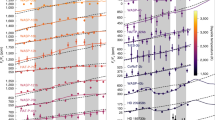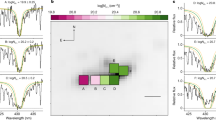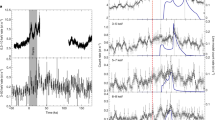Abstract
IN the account of his observations of the eclipse of January 22, 1898, published in the Philosophical Transactions, A 197, pages 389 and 399, Mr. Evershed directed attention to a curious continuous spectrum emitted by the solar chromosphere and prominences. This spectrum begins near the limit or head of the Balmer series of hydrogen lines, and extends with gradually decreasing intensity in the direction of shorter wave-lengths. In describing the phenomenon Evershed referred to the early observation by Huggins of an absorption in the corresponding region in the spectra of Vega and other stars having especially strong hydrogen lines (stars of Class A),1 and advanced the opinion that the spectrum, like the Balmer series which it so curiously supplements, is due to hydrogen. The grounds for this view were afterward strengthened through the discovery by Wood of a continuous spectrum occurring beyond the limit of the sodium series of dark lines, under conditions of laboratory experimentation that favoured the development of the higher members of the sodium series.2 More recently an emission spectrum, apparently identical in character with the one observed by Evershed in the chromosphere, has been found to be characteristic of the planetary nebulæ.3 The spectrum seems also to occur in the diffuse nebula N.G.C. 1499,4 and has been a conspicuous feature in the radiation of the. novæ. It may therefore be regarded as rather a commonplace phenomenon pertaining to the spectra of celestial objects which appear to exist under conditions of strong thermal or electrical excitation. For the purposes of this note I shall use the term outlying spectrum in referring to it in order to distinguish it from the general continuous spectrum of more uniform distribution which is found even in the gaseous or “bright-line” nebulæ.
This is a preview of subscription content, access via your institution
Access options
Subscribe to this journal
Receive 51 print issues and online access
$199.00 per year
only $3.90 per issue
Buy this article
- Purchase on Springer Link
- Instant access to full article PDF
Prices may be subject to local taxes which are calculated during checkout
Similar content being viewed by others
References
"An Atlas of Representative Stellar Spectra," p. 85. For a more complete investigation of the absorption in the Class A stars, see Hartmann, Physik. Zeit., 18, 429, 1917.
Astrophys. Jour., 29, 100, 1909.
Lick Obs. Bull., 9, 54, 1917; also Publ. Lick Obs., 13, 256, 1918.
Hubble, Publ. Astron. Soc. Pacific, 32, 155, 1920.
Ann. Chim. et Phys., (8), 9, 361, 1906.
Proc., 49, 530, 1920.
Phil. Mag., 26, 17, 1913.
Astrophys. Jour., 40, 258, 1914.
Lick Obs. Bull., 10, 103, Fig. 1.
Author information
Authors and Affiliations
Rights and permissions
About this article
Cite this article
WRIGHT, W. On the Continuous Radiation found in some Celestial Spectra beyond the Limit of the Balmer Series of Hydrogen. Nature 109, 810–812 (1922). https://doi.org/10.1038/109810a0
Issue Date:
DOI: https://doi.org/10.1038/109810a0
Comments
By submitting a comment you agree to abide by our Terms and Community Guidelines. If you find something abusive or that does not comply with our terms or guidelines please flag it as inappropriate.



